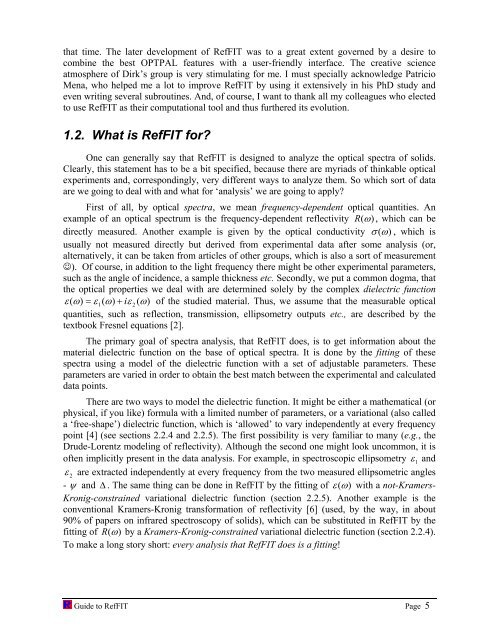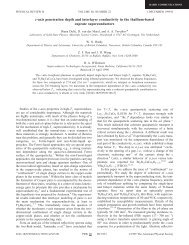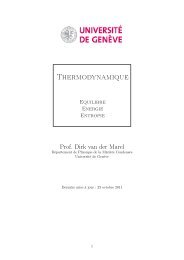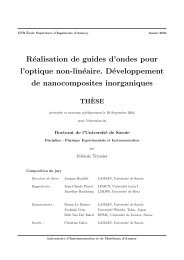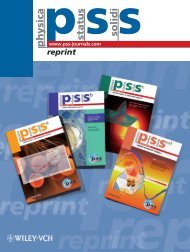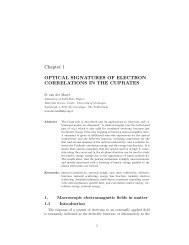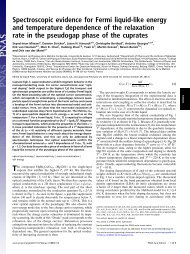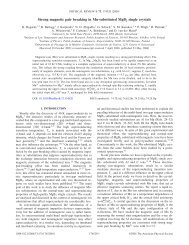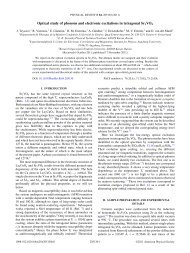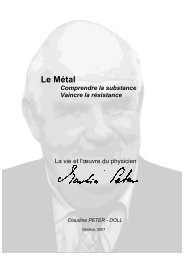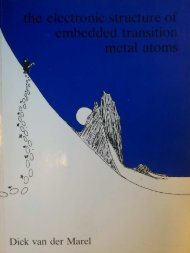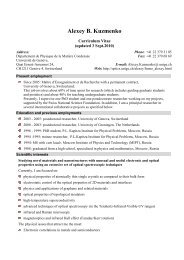software to fit optical spectra - Quantum Materials Group
software to fit optical spectra - Quantum Materials Group
software to fit optical spectra - Quantum Materials Group
You also want an ePaper? Increase the reach of your titles
YUMPU automatically turns print PDFs into web optimized ePapers that Google loves.
that time. The later development of RefFIT was <strong>to</strong> a great extent governed by a desire <strong>to</strong><br />
combine the best OPTPAL features with a user-friendly interface. The creative science<br />
atmosphere of Dirk’s group is very stimulating for me. I must specially acknowledge Patricio<br />
Mena, who helped me a lot <strong>to</strong> improve RefFIT by using it extensively in his PhD study and<br />
even writing several subroutines. And, of course, I want <strong>to</strong> thank all my colleagues who elected<br />
<strong>to</strong> use RefFIT as their computational <strong>to</strong>ol and thus furthered its evolution.<br />
1.2. What is RefFIT for?<br />
One can generally say that RefFIT is designed <strong>to</strong> analyze the <strong>optical</strong> <strong>spectra</strong> of solids.<br />
Clearly, this statement has <strong>to</strong> be a bit specified, because there are myriads of thinkable <strong>optical</strong><br />
experiments and, correspondingly, very different ways <strong>to</strong> analyze them. So which sort of data<br />
are we going <strong>to</strong> deal with and what for ‘analysis’ we are going <strong>to</strong> apply?<br />
First of all, by <strong>optical</strong> <strong>spectra</strong>, we mean frequency-dependent <strong>optical</strong> quantities. An<br />
example of an <strong>optical</strong> spectrum is the frequency-dependent reflectivity R (ω)<br />
, which can be<br />
directly measured. Another example is given by the <strong>optical</strong> conductivity σ (ω)<br />
, which is<br />
usually not measured directly but derived from experimental data after some analysis (or,<br />
alternatively, it can be taken from articles of other groups, which is also a sort of measurement<br />
☺). Of course, in addition <strong>to</strong> the light frequency there might be other experimental parameters,<br />
such as the angle of incidence, a sample thickness etc. Secondly, we put a common dogma, that<br />
the <strong>optical</strong> properties we deal with are determined solely by the complex dielectric function<br />
ε ( ω)<br />
= ε1<br />
( ω)<br />
+ iε<br />
2 ( ω)<br />
of the studied material. Thus, we assume that the measurable <strong>optical</strong><br />
quantities, such as reflection, transmission, ellipsometry outputs etc., are described by the<br />
textbook Fresnel equations [2].<br />
The primary goal of <strong>spectra</strong> analysis, that RefFIT does, is <strong>to</strong> get information about the<br />
material dielectric function on the base of <strong>optical</strong> <strong>spectra</strong>. It is done by the <strong>fit</strong>ting of these<br />
<strong>spectra</strong> using a model of the dielectric function with a set of adjustable parameters. These<br />
parameters are varied in order <strong>to</strong> obtain the best match between the experimental and calculated<br />
data points.<br />
There are two ways <strong>to</strong> model the dielectric function. It might be either a mathematical (or<br />
physical, if you like) formula with a limited number of parameters, or a variational (also called<br />
a ‘free-shape’) dielectric function, which is ‘allowed’ <strong>to</strong> vary independently at every frequency<br />
point [4] (see sections 2.2.4 and 2.2.5). The first possibility is very familiar <strong>to</strong> many (e.g., the<br />
Drude-Lorentz modeling of reflectivity). Although the second one might look uncommon, it is<br />
often implicitly present in the data analysis. For example, in spectroscopic ellipsometry ε 1 and<br />
ε 2 are extracted independently at every frequency from the two measured ellipsometric angles<br />
- ψ and ∆ . The same thing can be done in RefFIT by the <strong>fit</strong>ting of ε (ω)<br />
with a not-Kramers-<br />
Kronig-constrained variational dielectric function (section 2.2.5). Another example is the<br />
conventional Kramers-Kronig transformation of reflectivity [6] (used, by the way, in about<br />
90% of papers on infrared spectroscopy of solids), which can be substituted in RefFIT by the<br />
<strong>fit</strong>ting of R (ω)<br />
by a Kramers-Kronig-constrained variational dielectric function (section 2.2.4).<br />
To make a long s<strong>to</strong>ry short: every analysis that RefFIT does is a <strong>fit</strong>ting!<br />
Guide <strong>to</strong> RefFIT Page 5


